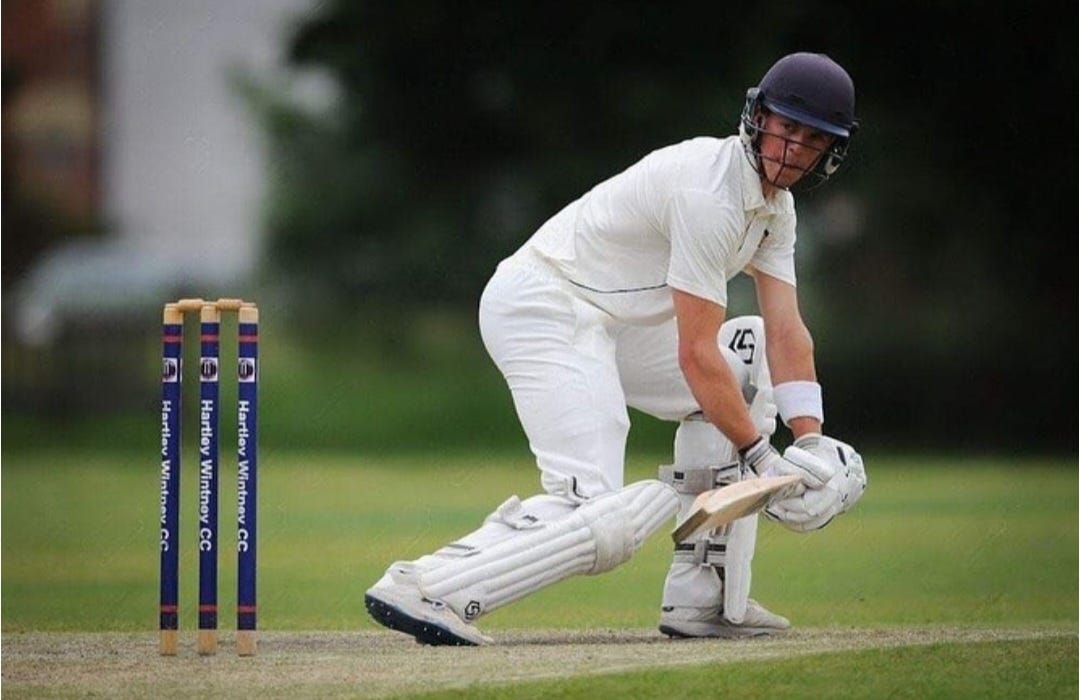St George’s Park was bare, save for the sprinkling of fans in the stands. Before his professional debut, an audience of 30 was the smallest crowd Matthew de Villiers had played in front of. That was during his time with Hambledon Cricket Club in the Hampshire League.
Hambledon is several tiers beneath the Warriors and yet this Division 1 side couldn’t pull as many people. On a bad day, Hambledon attracted 30 regular spectators and more than 100 people on a good day. Subtracting the members of each team’s party, there were probably less than 30 people watching the Warriors vs Dragons match.
De Villiers surveyed the ground from his post at the non-striker’s end and let out an involuntary laugh. Arno Jacobs, the standing umpire, didn’t hear it. It was audible, but not loud enough to travel from where De Villiers stood to Jacobs. It was a cross between a chuckle and a laugh.
However, that’s not why De Villiers was laughing. He was chortling because his name was on the giant screen at an international stadium where his hero had scored six Test half-centuries. He had just negotiated a delivery from Migael Pretorius, a well-travelled professional; was surrounded by some of the best cricketers in the country, and was unbeaten on 72 on his First Class debut. It didn’t matter to him that no one was watching.
“It was a pinch-me moment. I worked for that moment all my life and, finally, I was living my dream,” De Villiers shared.
A tickey (or tikkie) was a South African threepenny piece. It was replaced by a five-cent coin in 1961. Both coins lost their buying power a long time ago, however, the name stuck around, until it ceased to be a reference of a specific value. It now refers to a small amount that parents hand out to kids for sweets and biscuits at school.
De Villiers was around nine years old when he fell in love with a Nintendo console. He wanted one so much that he did not spend his tickies. His desire for it was stronger than his childish sweet tooth. He saved every cent he got from his father, mother, and uncles. By January 2012, he had enough.
“My mother took me to Makro to get it, because Makro had good prices,” De Villiers recalled.
The moment is etched in De Villiers’ memory. Mother and son stood before close to 40 TV screens at the electronics section while waiting for someone to attend to their need. All of them were on and broadcasting the Test match between South Africa and Sri Lanka at Newlands.
De Villiers grew up in a cricket-loving family. ESPNCricinfo describes his uncle, Pieter Strydom as a useful spinner and middle-order batter who never reached his potential. Strydom featured in a couple of Test matches and 10 ODIs towards the end of his 17-year professional career.
They attended so many matches at Newlands, De Villiers could have been raised on the embankments. De Villiers has memories of his father on a camping chair while he played improvised matches with other youngsters.
The one match they missed was the one Jacques Kallis decided to register his highest Test score. The timbre of the commentators’ voices told him that something special was about to happen, Kallis was on 198. De Villiers stood in the store, transfixed to the screen for what seemed to be an eternity, as Kallis and AB de Villiers navigated the eight deliveries it took the all-rounder to get to a double century.
“I completely forgot about the Nintendo as I watched Kallis. I had always enjoyed cricket but that was the moment I knew I wanted to be a professional cricketer,” De Villiers shared.
Since 1992, less than a third of South Africa’s international cricketers have come from schools other than the traditional powerhouses. De Villiers' father was a painter, and his mother a homemaker. He went to Kirstenhof Primary School, and they couldn't afford to send him to any of the top cricket high schools in the Western Cape. The odds were stacked against him.
Robert Merton introduced the Matthew Effect to the world in 1968. It is based on a verse in the Gospel of Matthew (13:12). The Matthew Effect refers to a pattern in which those who begin with advantage accumulate more advantage over time and those who start at a disadvantage become more disadvantaged over time. The result is ever-widening differences between the advantaged and disadvantaged.
De Villiers didn't know about Merton or the Matthew Effect, however, he approached the game with the mindset of someone who knew they had to work twice as hard to get noticed. He mowed junior bowling attacks and hauled bags of wickets in match after match. However, people in cricket circles refused to take his stats at face value because they didn't think he competed against strong opposition.
That said, a city on a hill cannot be hidden. Word of his ability reached Eric Lefson and Sean Hewitt at Wynberg Boys' High. They invited De Villiers to the u14 trials. While they put an asterisk on his runs, they thought there might be something in his bowling to work with.
When he got there, De Villiers showed them that bowling was a secondary skill. He scythed bowlers left, right and centre. Then he outperformed his peers in fielding drills. However, what impressed Lefson the most was De Villiers’ conduct. The youngster was always ready to give other trialists a hand, congratulate them when they did well, and didn’t slump his shoulders when something didn’t go his way.
“I liked him straight away. He was, by far, the best player at the trials but didn’t have any airs and graces. He had good body language,” Lefson explained.
Ever the well-mannered individual he was, De Villiers thanked Lefson and Hewitt for the opportunity to audition for them and left. He didn’t get his hopes up as he left the school and forgot about the trials until the day his mother interrupted his lesson.
“She came to see me at school. She had tears in her eyes when she handed me the envelope. It was the scholarship offer from Wynberg,” De Villiers recalled.
His mother knew how much her son needed the break. She saw how much he wanted to be a cricketer. She and her husband would never have been able to get their son into Wynberg or another school that could help him on his path.
“My mother was incredibly grateful for the scholarship. It meant so much to her because it meant so much to me,” De Villiers explained.
De Villiers paid Lefson back by being the glue guy. He dug them out of holes, was the ultimate team player and piled on runs for them.
“The intangibles were his strength. He excelled at a lot of things that don’t show up on the stat sheet. He was good under pressure and stood up in tough moments. You have guys who can come in and perform when the team is on 200/2. Matthew came through when the team was on 10/2 and pulled the team out of trouble,” said Lefson, who described De Villiers as a low-maintenance player Wynberg could always rely on.
Kallis lit the fire in him to pursue cricket with a steely single-mindedness. De Villiers’s decisions from the time he was 12 were made with one question: how did it impact his dream to play professional cricket? Wynberg Boys’ High fortified his technique and Pieter Strydom gave him advice he has carried in his breast pocket into every match.
“My uncle made it clear to me that technique is important, but cricket is a game of a mental capacity 90% of the time,” De Villiers shared.
De Villiers carried all three into every match he played. That’s how he broke the ECB’s Southern Premier League’s 17-year-old run record. He was so prolific he scored twice as many runs as the second-highest run-getter in the league in 2022. De Villiers was also a fan-favourite at Oakmere CC and Longridge CC, two other UK clubs he played for in 2021 and 2023.
“Walter Payton proved Sunday the Bears are not a one-man team. They are a one-superman team," Don Pierson wrote in 1977 after Walter Payton sensationally led the Chicago Bears to the NFL title. Payton was the Bears' everything man and he demolished the Minnesota Vikings.
Claremont CC needed someone to be their Walter Payton in their quest for the Western Province Premier League title. The club has had legendary players, including Gary Kirsten, but none had ever been able to win the trophy.
“He was the top run-scorer in the league by a long way. His numbers were off the charts,” Richard Pybus summed up De Villiers’ trophy-winning season with Claremont.
Pybus watched De Villiers in one of his matches for Claremont and couldn’t believe his eyes. Brad Barnes told Lefson that De Villiers was the best batter he had seen in a while, Pybus arrived at the same conclusion as he witnessed De Villiers construct an unbeaten century.
“It was a brilliantly structured innings. It was proper batting and he saw his team over the line,” Pybus explained.
Pybus and De Villiers had a chat after that match. It didn’t take long for the seasoned coach to realise that something was eating away at De Villiers. The batter felt stuck. He was enjoying success on the field, but his career was not moving in the direction he hoped.
“How badly do you want this?” Richard Pybus asked De Villiers. The celebrated coach would have gotten the same answer whether he had asked 12-year-old or 22-year-old De Villiers. The struggles of the past decade had not diminished his drive to be a professional cricketer.
Pybus helped De Villiers create a cricketing CV, then went to every franchise shopping the batter around. They all told him that they were sorted in the position De Villiers played. Then the Western Province Colts, the team De Villiers captained, was invited to give MICape Town. He scored a quickfire 40-something on a turning surface.
“Robbie P called me afterwards and told me that he had been keeping an eye on me. He thought I had potential and told me he was going to give me a chance at the Warriors,” De Villiers recalled.
De Villiers waited for years to get a shot at the Western Province Colts. When he did, he scored a couple of daddy hundreds and a half-century for them for an average of more than 100 in a four-match run. He grabbed that opportunity with both hands. That’s also what he did after Robin Petersen gave him a chance with the Warriors.
De Villiers has big dreams, but for the moment, he is enjoying this part of his journey.







